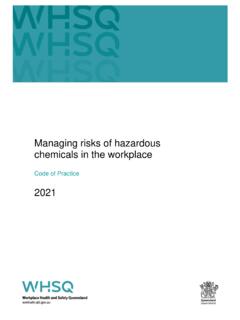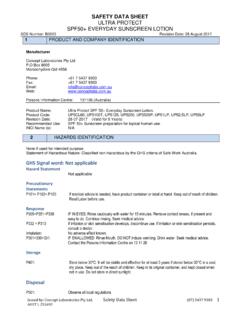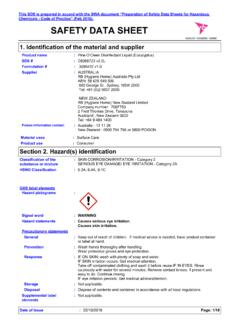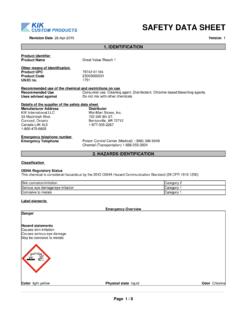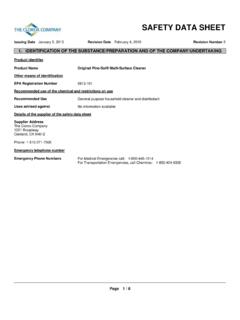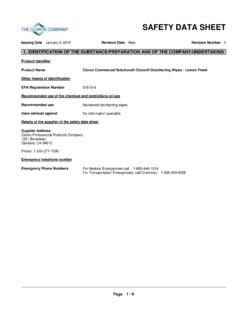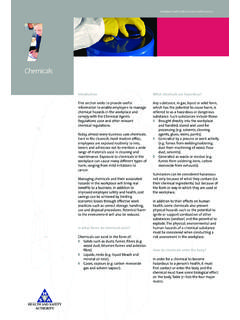Transcription of Piping and Instrumentation Diagram Documentation …
1 COMPLETE REVISION P&ID SamplePIP PIC001 Piping and Instrumentation Diagram Documentation CriteriaSample - Not for Commercial Use PURPOSE AND USE OF PROCESS INDUSTRY practices In an effort to minimize the cost of process industry facilities, this Practice has been prepared from the technical requirements in the existing standards of major industrial users, contractors, or standards organizations. By harmonizing these technical requirements into a single set of practices , administrative, application, and engineering costs to both the purchaser and the manufacturer should be reduced. While this Practice is expected to incorporate the majority of requirements of most users, individual applications may involve requirements that will be appended to and take precedence over this Practice. Determinations concerning fitness for purpose and particular matters or application of the Practice to particular project or engineering situations should not be made solely on information contained in these materials.
2 The use of trade names from time to time should not be viewed as an expression of preference but rather recognized as normal usage in the trade. Other brands having the same specifications are equally correct and may be substituted for those named. All practices or guidelines are intended to be consistent with applicable laws and regulations including OSHA requirements. To the extent these practices or guidelines should conflict with OSHA or other applicable laws or regulations, such laws or regulations must be followed. Consult an appropriate professional before applying or acting on any material contained in or suggested by the Practice. This Practice is subject to revision at any time. Process Industry practices (PIP), Construction Industry Institute, The University of Texas at Austin, 3925 West Braker Lane (R4500), Austin, Texas 78759. PIP Member Companies and Subscribers may copy this Practice for their internal use.
3 Changes or modifications of any kind are not permitted within any PIP Practice without the express written authorization of PIP. Authorized Users may attach addenda or overlays to clearly indicate modifications or exceptions to specific sections of PIP practices . Authorized Users may provide their clients, suppliers and contractors with copies of the Practice solely for Authorized Users purposes. These purposes include but are not limited to the procurement process ( , as attachments to requests for quotation/ purchase orders or requests for proposals/contracts) and preparation and issue of design engineering deliverables for use on a specific project by Authorized User s client. PIP s copyright notices must be clearly indicated and unequivocally incorporated in documents where an Authorized User desires to provide any third party with copies of the Practice. Note: PIP PIC001, Piping and Instrumentation Diagram Documentation Criteria, incorporates symbols previously published in standards owned and copyrighted by The Instrumentation , Systems, and Automation Society (ISA).
4 These are printed with agreement from ISA. PUBLISHING HISTORY November 1998 Issued April 2008 Complete Revision Not printed with State funds Sample - Not for Commercial Use COMPLETE REVISION April 2008 P&ID Process Industry practices Page 1 of 43 PIP PIC001 Piping and Instrumentation Diagram Documentation Criteria Table of Contents 1. Introduction .. 2 Purpose .. 2 Scope .. 2 2. References .. 2 Process Industry practices .. 3 Industry Codes and Standards .. 3 Government Regulations .. 3 3. Definitions .. 3 4. Requirements .. 6 General .. 6 Format .. 6 Equipment .. 11 Piping .. 17 Instrumentation and Controls .. 20 Appendixes Appendix A Detailed Equipment Labels PIC001-A-001-1 Appendix A Suggested Detailed Equipment Labels PIC001-A-001-2 Appendix A Suggested Detailed Equipment Labels Appendix B Legend Sheets PIC001-B-001 Appendix B-1 Typical Piping Legend Sheet PIC001-B-002 Appendix B-2 Typical Instrumentation Legend Sheet PIC001-B-003-1 Appendix B-3 Driven Equipment Legend Sheet PIC001-B-003-2 Appendix B-3 Heat Transfer Equipment Legend Sheet PIC001-B-003-3 Appendix B-3 Vessels & Tanks Legend Sheet PIC001-B-003-4 Appendix B-3 Solids & Material Handling Equipment Legend Sheet PIC001-B-003-5 Appendix B-3 Fire & safety Equipment Legend Sheet PIC001-B-004 Appendix B-4 Typical Details with Implied Components Appendix C Example P&IDs PIC001-C-001 Appendix C-1 Example Process P&ID 1 PIC001-C-002 Appendix C-2 Example Process P&ID 2 PIC001-C-003 Appendix C-3
5 Example Utility P&ID Appendix D P&IDs for the Hygienic Processing Industries PIC001-DB-001 Appendix DB-1 Hygienic Process Piping Legend Sheet PIC001-DB-002 Appendix DB-3 Hygienic Process Equipment Legend Sheet PIC001-DC-001 Appendix DC-1 Hygienic Process Example Process P&ID 1 PIC001-DC-002 Appendix DC-2 Hygienic Process Example Process P&ID 2 PIC001-DC-003 Appendix DC-3 Hygienic Process Example Process P&ID 3 Sample - Not for Commercial UsePIP PIC001 COMPLETE REVISION Piping and Instrumentation Diagram Documentation Criteria April 2008 1. Introduction Purpose This Practice provides requirements for designers preparing Piping and Instrumentation diagrams (P&IDs). Scope This Practice describes the requirements for P&ID format and content. The Practice is independent of time in a facility life cycle and encompasses design, construction, operations, and maintenance.
6 This Practice covers the generation of new P&IDs and does not apply to the revision of existing P&IDs. This Practice also applies to P&IDs provided by packaged equipment vendors. This Practice applies to all diagrams that fit the definition of a P&ID in Section 3. The requirements provided in this Practice can be applied to any CAD system used for developing the P&IDs and are not vendor, hardware, or software specific. The requirements provided in this Practice provide a balance between showing all data on P&IDs and making P&IDs legible and easy to read. While this Practice is expected to incorporate the majority of requirements of most users, individual applications may involve requirements that will be appended to and take precedence over this Practice. Determinations concerning fitness for purpose and particular matters or application of the Practice to particular project or engineering situations should not be made solely on information contained in these materials.
7 The example P&IDs included in the Appendixes of this Practice are not intended to recommend specific design details or requirements. Example P&IDs are included to provide an illustration of how the elements of this Practice are combined into a P&ID. Electronic native files for the text, symbols, and cover sheets are available to PIP Member Companies for input to members CAD systems. Development of project-specific cover sheets is recommended using the PIP native files as a starting point. Additions and/or deletions are allowed to meet requirements. Cover sheet borders and title blocks can be altered. 2. References Applicable parts of the following practices , industry codes and standards, and references shall be considered an integral part of this Practice. The edition in effect on the date of start of P&ID development shall be used, except as otherwise noted. Short titles are used herein where appropriate. Process Industry practices (PIP) PIP INEG1000 Insulation Design and Type Codes PIP PCCIP001 Instrument Piping and Tubing Systems Criteria PIP PCSIP001 Instrument Piping and Tubing Systems Specifications Page 2 of 31 Process Industry practices Sample - No Commercial UseCOMPLETE REVISION PIP PIC001 April 2008 Piping and Instrumentation Diagram Documentation Criteria PIP PNE00001 Design of ASME Metallic Piping Systems PIP PNSM0001 Piping Line Class Designator System Industry Codes and Standards American National Standards Institute (ANSI) ANSI/FCI 70-2-2003 Control Valve Seat Leakage American Society of Mechanical Engineers (ASME) ASME Boiler and Pressure Vessel Code Section VIII Pressure Vessels The Instrumentation , Systems, and Automation Society (ISA)
8 ISA Instrumentation Symbols and Identification ISA Binary Logic diagrams for Process Operations ISA Graphic Symbols for Distributed Control / Shared Display Instrumentation , Logic and Computer Systems ISA Application of safety Instrumented Systems for the Process Industries Tubular Exchanger Manufacturers Association (TEMA) TEMA Standards Government Regulations Occupational safety and Health Administration (OSHA) OSHA 29 CFR Occupational safety and Health Standards, Process safety Management of Highly hazardous Chemicals 3. Definitions For the purposes of this Practice, the following definitions apply: accessible: Term applied to a device or function that can be used or seen by an operator for the purpose of performing control actions ( , set point changes, auto-manual transfer, or on/off actions) (Reference ISA ) automated valve: Any valve with a locally or remotely controlled actuator.
9 Examples are throttling control valves and on/off block valves. Actuators are typically air-operated (diaphragm or piston), electric or hydraulic, some with a spring-return function. Manually-operated valves are sometimes tagged as automated valves ( , if a manual valve is fitted with position switches). auxiliary P&ID: Used to show details to unclutter other P&IDs ( , lube oil system, sample systems, instrument details) Basic Process Control System (BPCS): Control equipment and system installed to regulate normal production functions. It may contain combinations of single-loop pneumatic controllers, single-loop electronic controllers, Programmable Logic Controllers (PLCs), and Distributed Control Systems (DCSs). The BPCS is required to operate the process. Examples of control Process Industry practices Page 3 of 31 Sample - No Commercial UsePIP PIC001 COMPLETE REVISION Piping and Instrumentation Diagram Documentation Criteria April 2008 functions included in the BPCS are cascade control, override control, and pump start/stop.
10 Also known as Basic Regulatory Controls. (See also HLCS and SIS) bubble: Circular symbol used to denote and identify the purpose of an instrument or function. The bubble usually contains a tag number. (Synonym for balloon) (Reference ISA ) design pressure: Pressure used in the design of a vessel component together with the coincident design metal temperature for determining the minimum permissible thickness or physical characteristics of the different zones of the vessel. (Reference ASME Boiler Pressure Vessel Code, Section VIII, Division 1, Appendix 3) fail closed (FC): Characteristic of an automated valve that causes the valve to close as a result of specific malfunctions, including loss of signal or motive power. (Reference ISA ) fail indeterminate (FI): Characteristic of an automated valve that causes the valve to move to an unknown position as a result of specific malfunctions, including loss of signal or motive power. Some automated valves will not stay at the last position upon failure and instead move with the process differential pressure.
